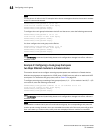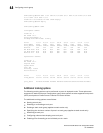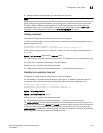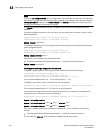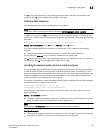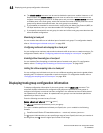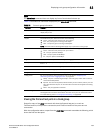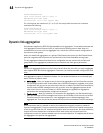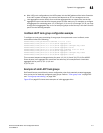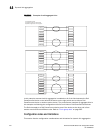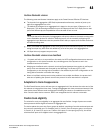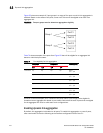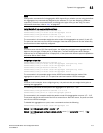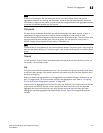
410 PowerConnect B-Series FCX Configuration Guide
53-1002266-01
Dynamic link aggregation
12
PowerConnect#show mac
Total active entries from all ports = 1
MAC-Address Port Type Index
0007.e910.c201 1/1/7*1/1/21 Dynamic 2920
For a trunk group with members 1/1/7 to 1/1/9, the output from the show mac command
resembles the following.
PowerConnect#show mac
Total active entries from all ports = 1
MAC-Address Port Type Index
0007.e910.c201 1/1/7-1/1/9 Dynamic 2920
Dynamic link aggregation
Dell software supports the IEEE 802.3ad standard for link aggregation. This standard describes the
Link Aggregation Control Protocol (LACP), a mechanism for allowing ports on both sides of a
redundant link to form a trunk link (aggregate link), without the need for manual configuration of
the ports into trunk groups.
When you enable link aggregation on a group of Dell PowerConnect ports, the Dell PowerConnect
ports can negotiate with the ports at the remote ends of the links to establish trunk groups.
The link aggregation feature automates trunk configuration but can coexist with the Dell trunk
group feature. Link aggregation parameters do not interfere with trunk group parameters.
NOTE
Use the link aggregation feature only if the device at the other end of the link you want to aggregate
also supports IEEE 802.3ad link aggregation. Otherwise, you need to manually configure the trunk
links.
Link aggregation support is disabled by default. You can enable the feature on an individual port
basis, in active or passive mode:
• Active mode – When you enable a port for active link aggregation, the Dell PowerConnect port
can exchange standard LACP Protocol Data Unit (LACPDU) messages to negotiate trunk group
configuration with the port on the other side of the link. In addition, the Dell PowerConnect port
actively sends LACPDU messages on the link to search for a link aggregation partner at the
other end of the link, and can initiate an LACPDU exchange to negotiate link aggregation
parameters with an appropriately configured remote port.
• Passive mode – When you enable a port for passive link aggregation, the Dell PowerConnect
port can exchange LACPDU messages with the port at the remote end of the link, but the Dell
PowerConnect port cannot search for a link aggregation port or initiate negotiation of an
aggregate link. Thus, the port at the remote end of the link must initiate the LACPDU exchange.
NOTE
Dell recommends that you disable or remove the cables from the ports you plan to enable for
dynamic link aggregation. Doing so prevents the possibility that LACP will use a partial configuration
to talk to the other side of a link. A partial configuration does not cause errors, but does sometimes
require LACP to be disabled and re-enabled on both sides of the link to ensure that a full
configuration is used. It's easier to disable a port or remove its cable first. This applies both for active
link aggregation and passive link aggregation.



